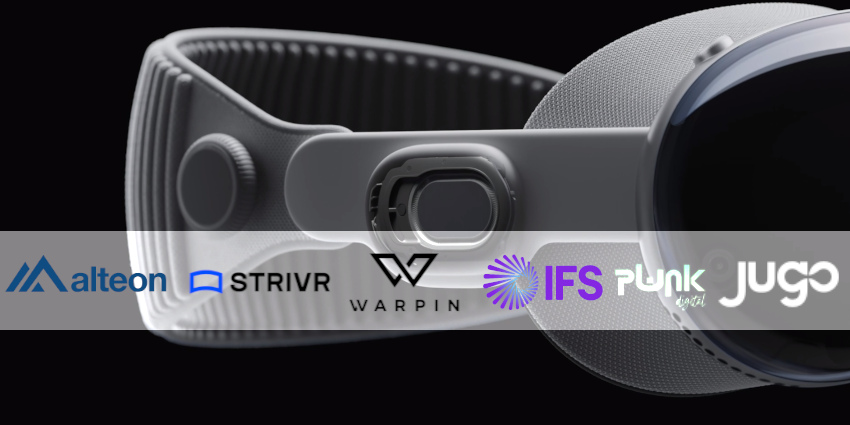Apple’s Vision Pro triggered new discourse on the future of virutal, augmented, and mixed reality (VR/AR/MR). Revealed at the Worldwide Developer Conference (WWDC), the Apple Vision Pro has sparked both praise and criticism from the global XR community. Apple’s take on immersive technologies will also test the future of XR hardware solutions and their roles in the broader XR community through rigorous use cases.
Mark Zuckerberg, Chief Executive and Founder, Meta Platforms, recently hit back at the device, stating it was not his company’s vision for XR.
Following the event, several global executives from the immersive tech industry weighed in on the device. For the conversation, XR Today is pleased to invite the following:
- Matt Cimaglia, Chief Executive and Co-Founder, Alteon.io
- Brian Meaney, Head of Product, Alteon.io
- Aneesh Kulkarni, Chief Technology Officer, Strivr
- Emma Ridderstad, Chief Executive and Co-Founder, Warpin Reality
- Juan Martinez, Founder and Managing Director, PWNK.digital
- Joseph Toma, Chief Executive, Jugo
- Kevin Miller, Chief Technology Officer, North America, IFS
The panel discussed thoughts on Apple’s Vision Pro headset, its future use cases, and how the device would build specific key technologies for the global XR community, among other topics.
XR Today: What were your initial thoughts on the Vision Pro?

Matt Cimaglia: This will be the worst version of the Vision Pro we’ll ever see—and that’s incredibly exciting. We know it will only improve in sophistication, technology and design.
The fact that they are calling it Vision Pro indicates that there will be a comparable version to the iPhone SE, to one day draw in a broader audience. This is a significant launching pad, and it already looks excellent.
Apple is adept at proposing something you didn’t think you needed. Now, all of a sudden, the world is going to want this product. Apple is throwing rocket fuel on the AR space, and we think this will spark meaningful competition. This will lead to more money invested in research and development (R&D) to make a lighter-weight glass for the AR experience. This could actually be quite beneficial for Meta, Microsoft, and Magic Leap.
When you look at past technology that didn’t quite take off, it was because there wasn’t enough competition. When you look at streaming channels, they compete against each other and make better content. With Vision Pro, Apple is now in the AR race, everyone gets to compete. The race has started.
Aneesh Kulkarni: Apple’s Vision Pro announcement last week is very likely to be one of the ‘watershed moments’ for the VR and AR industry. The long-awaited announcement gives a boost and, hopefully, greater confidence to the space, now that two of the world’s biggest tech companies, Meta and Apple, will compete for market share.
The initial event and follow-up conversations have generated the necessary buzz and set expectations that “spatial computing” will be a part of everyday life. This is just like other Apple devices we’ve come to know, use, and love in our day-to-day personal and professional lives.
Apple does an incredible job at positioning and launching technology that appeals to individuals on a personal level. If you consider the technologies that have been adopted expansively by consumers and, later, by enterprises, there’s a strong connection and understanding from individuals as to how it benefits their life, work, and well-being.
That’s when more and more people begin using it in their personal and professional lives, leading to widespread adoption.
Emma Ridderstad: My initial thoughts on the Vision Pro were that it was a really clean, sleek design, and that the features Apple displayed seemed very high quality. What more would we expect from Apple?
It was great to see that the device would be controlled using our hands, instead of external controllers, meaning that it is far more intuitive for people to use and should ensure success when the product is released.
It’s also interesting to see how Apple is prioritising its use cases within its existing ecosystem of apps and content – something that Meta, for good or bad, has never had to consider in its situation.

Joseph Toma: Apple’s new headset introduced a digital world for which the real world isn’t ready. Apple is behind the ball here, with the advancements in spatial and mixed reality AI.
Platforms already exist that provide the immersion Apple offers but without the need to have a bulky — and very expensive — piece of hardware strapped to your face.
Juan Martinez: Essentially, my initial thought was that it was a serious piece of kit, packed with cutting-edge technologies and a lot of powerful capabilities.
XR Today: How was Apple’s presentation of the device? Did they leave anything out, or did they tick specific boxes?
Brian Meaney: There are many reasons and key differences that Apple considered in developing the Vision Pro that give it far more potential than other VR/AR devices.

For example, they are lowering the cameras and sensors so users’ hands aren’t getting tired. Also, they’re embracing the VR side, which eliminates many technical challenges that come with making a device for true AR, in which the device’s glasses display the real world.
For example, small rooms or tight spaces have always been tricky: you can’t easily use an AR headset on an airplane, because objects will collide with the real world — seats, fellow passengers, and so forth — and become obstructed, or else you have to start bending what is augmented.
But Apple decided to dim the world, so to speak, creating a theater-like experience. Being able to turn everything else off — leaning into VR — means that use cases are more valid and useful. And then there is the ecosystem. They have all that on there right away, and it’s familiar to what users already know.
Aneesh Kulkarni: It was an impressive presentation, and they checked a lot of boxes. I would have loved to see more about the development of 3D content. I assume that will come between now and when the headset is available for sale.

They also demonstrated significant advancements in hardware. The M2 delivers unparalleled standalone processing performance, while the new R1 chip is specialized to process input from the cameras, sensors, and microphones to enable what looked like high fidelity, low latency passthrough for a real-time sense of presence.
The 3D interface in visionOS that users can naturally control with hands, voice, and eyes, makes for a hands-free experience. The gestures seemed natural and intuitive. Not needing a controller in both hands should significantly reduce the friction that comes with acclimation in a headset. I expect advancements like this to help with adoption. The Vision Pro is going to help people feel more comfortable with immersive technology.
Additionally, spatial computing and this new user experience are going to spur a lot of creative content development. I’m looking forward to learning more about RealityKit and Reality Composer.
The reveal that Apple will be using Unity to bring 3D applications and games to Vision Pro was exciting. I think this will help accelerate the development of new applications and games and accelerate the port of existing applications and games to Vision Pro.

Emma Ridderstad: Apple’s presentation of the device didn’t fully demonstrate the range of VR activities that can be achieved. There were a lot of ‘looking and clicking’ functions — things you can also do on your phone.
There was a demonstration of how you could use the headset to help you work and communicate with others, but there could have been more focus on this, instead of on the entertainment functions. Apple was also a bit thin on the ‘native’ 3D MR experiences and third-party showcases. This is likely to change before the release date.
Joseph Toma: [From the presentation], although the hardware will inevitably evolve, we are years away from consumers and businesses adopting these tools. Also, while converging the physical and virtual worlds is inevitable, it won’t be through massive ski goggles on your face. Instead, it will take place with spatial and mixed AI, all done through your personal device. Apple has missed that this is possible today, not tomorrow.
Juan Martinez: I thought the presentation was good and wanted to highlight some things.
The device is a bridge to those that are not used to wearing headsets and VR technologies. Apple’s approach was not to get everyone into virtual worlds right away, but it was a great way to meet audiences halfway. This was done by introducing flat, resizeable virtual screens to maximise productivity.
Apple also presented the Vision Pro as a productivity tool, rather than simply entertainment hardware. The presentation covered a lot of aspects, but that was the one that spoke to me the most.
XR Today: Who is the target audience for the headset? What specific use cases do you expect to come from this device?
Matt Cimaglia: I see developers and content creators gaining the most from the initial launch, as they will pave the way for future uses. They will need to witness and experience augmented reality, extensively and firsthand, in order to build apps and content for it.
Apple has an advantage against its competitors here, mainly since they already have an App Store supported by droves of developers who are no doubt eager to try this new hardware and start creating innovative experiences. These early adopters may not create polished work, but their experiments and ideas will blossom in years to come.
It will also find early success among corporate entities, such as companies and event organizers. Exhibitioners at car shows could take passersby for a virtual test drive of their latest model. Travel companies could take clients on walking tours of far-flung cities from a convention floor.
Some of this may be thinking too far in the future, but companies would have the money to invest in a Vision Pro and the desire to draw a crowd at that sort of venue.
Aneesh Kulkarni: I think the target audience is the consumer, and it is the professional consumer (prosumer) who will use the headset in their enterprise’s workflow.
The audience will grow beyond that as new generations of the headset improve the form factor, taking it closer to the style of smart glasses and a lower price point, helping the vast audience of enterprise and industrial employees in their workflows.
If you consider virtual reality over the last few years, there has been increasing traction in the enterprise. Learning and training have probably become the biggest use case across industries. Additionally, sports, retail, logistics, healthcare and, more recently, financial services will lead the way.
As Apple’s entry into the space boosts confidence, triggers competition with and spurs similar and more advancements in other headsets, more people will likely use mixed reality headsets in their day-to-day lives. Enterprise users will be more likely to spend time in the headset, and this should even further accelerate training, learning, and development use cases for enterprises.
Further use cases will span media and entertainment, games, collaboration and design, in addition to education, training, learning and development.
Emma Ridderstad: From the presentation, you’d be forgiven for thinking that the target audience is individual consumers — the price point for the headset means that won’t really be the case.
Realistically, we’re likely to see businesses using this technology first, because the headset can unlock many possibilities in the workplace and for communication. It takes the ‘Zoom revolution’ to a whole new level: you can talk to your colleagues and feel they’re in the same room.
Another core target group for this version of the device is also developers. Some might even call this version ‘generation zero’ rather than ‘generation one’ to drive this sentiment home as it is such a new and fresh product.

Juan Martinez: I can see several use cases, with the first being for working and maximising productivity, especially while on the go. You can have very large screens in your workspace, and design it how you want it to take with you, rather than physical spaces becoming a limiting factor. I believe this translated very well in the presentation.
In terms of functioning as a working piece of kit, you will have to remember Apple has powered this with an M2 chip. This is the equivalent of strapping a high-grade laptop to your face, so yes, we can expect to do a lot of serious work to it.
It will also interoperate with other Apple devices like the MacBook Pro, iPhone, and iPad, and you can connect your MacBook to work on it simultaneously.
I also commended the focus on gaming and entertainment for the device. Their partnership with Unity will get them there quickly. This certainly means that lots of games developed in VR will take little effort to port to the Vision Pro and its massive developer base.
There are already a lot of developers on Unity, so I understand that developing for the Vision Pro will be quite effortless. Those are the two main things that I noticed.
Kevin Miller: I can simply speak about the broader implications and use cases for augmented reality technologies in the field. Similarly to what Apple has released, AR has the potential to impact both manufacturing and field services significantly. This is specifically done by enhancing productivity, efficiency, and safety.
In manufacturing, enterprises can use AR to visualise and manipulate 3D models in real-time, enabling engineers and designers to assess product designs and make modifications quickly. This can accelerate the prototyping phase and improve design accuracy.

AR can guide workers through complex assembly processes by overlaying digital instructions onto real-world objects for assembly and production. This helps reduce errors, minimize training time, and enhance overall productivity. Think of training-of-process steps on the manufacturing shop floor.
AR can also assist in quality inspections by highlighting defects, providing real-time feedback, and comparing finished products to digital reference models. This ensures consistency and accuracy in the manufacturing process.
Furthermore, AR can aid technicians in troubleshooting and performing maintenance tasks by overlaying step-by-step instructions, diagrams, and relevant data onto physical equipment. This reduces downtime and enhances efficiency.
In remote assistance, AR allows field service technicians to collaborate with remote experts in real-time. By using AR-enabled smart glasses or mobile devices, technicians can share their live view, receive guidance, and access documentation hands-free. This improves first-time fix rates and reduces the need for on-site visits.
AR-based training modules can provide field service personnel with immersive and interactive learning experiences. They can practice complex procedures, simulate real-world scenarios, and access contextual information, leading to faster skill acquisition and reduced training costs.
The technology can additionally offer real-time visualizations of equipment, displaying relevant maintenance data, service history, and diagnostic information. Technicians can identify issues more efficiently, access manuals and guides, and follow step-by-step instructions, improving service accuracy and speed.
Augmented reality can streamline documentation processes by automatically capturing data, annotations, and images during field service activities. This simplifies report generation, reduces paperwork, and ensures accurate records.
Overall, AR empowers manufacturing and field service professionals with real-time information, improved collaboration, and enhanced visualization, leading to increased efficiency, reduced errors, and improved outcomes.
Our company currently offers this for field services via a partner product called Help Lightning. This creates assisted augmented reality sessions with technicians and others, similar to FaceTime.
XR Today: Do you believe the Vision Pro will build interoperability for the XR market, or build Apple’s app ecosystem?
Matt Cimaglia: Apple has a long history of developing proprietary technology and working internally. At Alteon.io, we’ve been fortunate to work alongside their teams to develop our apps and workflow extensions specifically for Apple products, seeing their commitment to content creators firsthand.
Part of their longstanding success can be attributed to their extensive quality control, unique design process and full control over their product development. That’s what gives Apple devices the look and feel they have.
While it’s impossible to guess the future, interoperability between headsets will likely mirror the landscape of Android and Apple smartphones, or Mac and Windows computers.
Apple will most likely stand out in the market for its unique feel, best-in-class visuals and technology, and intuitive user experiences, keeping with the overall cohesion between various devices.
They continue to support and collaborate with outside companies, of course — you’ll probably be able to use Google Maps on the Vision Pro, for example — but I wouldn’t expect the competitive atmosphere to change much.
Aneesh Kulkarni: I think Apple wants you to build for their ecosystem. They have a rich, highly interoperable one with Macs, iPhones, Watch, and now the Vision Pro. This is Apple’s biggest advantage over other platforms as they index on a seamless experience for users across these devices.
We will have to wait and see if Apple prioritizes interoperability across the XR market. Will they contribute to and support the OpenXR standard? Apple will use Unity to bring 3D applications and games to Vision Pro.
Unity has been built for interoperability with things like the XR interaction toolkit and support for the OpenXR standard. Will Unity’s new PolySpatial technology enable interoperability across headsets? It remains to be seen.
On the flip side, I can see a splash effect from creators excited to build for Apple. There is this other inflexion point with Generative AI — enabling content creation to become not just more accessible, but accelerated at a much lower cost. I believe there will be more excitement around 3D apps and content development, which will raise the tide around content development for all platforms and headsets like Meta, Pico, and HTC VIVE.
Emma Ridderstad: It is possible that the Vision Pro will build out Apple’s app ecosystem, but unlike when Apple released the first iPhone or the first Mac, the XR market has already pioneered software that takes XR beyond entertainment purposes. To make Vision Pro a success, I think Apple will have to build interoperability into its devices so that the headsets don’t become glorified TVs.
There is hardware ‘interoperability’ already in the Vision Pro, in the sense that some of the features, like eye tracking, will become more mandatory for future devices of other manufacturers. On the software side, they have so far chosen not to support the industry interoperability standard OpenXR.
XR Today: Did Apple select the right initial partnerships for this device? Where do you expect them to lead?
Matt Cimaglia: Disney coming into the mix brings this full circle to Steamboat Willie — one of the first animated pictures with synchronized audio. That was mind-blowing for people at the time. We don’t know in the next 25 to 40 years what the media landscape will look like or how we’re going to be consuming content.
I believe the future of storytelling will prominently feature nonlinear experiences, which goes back to the silent film era when nickelodeons would play short films on a constant loop. No matter what time you walked in, you’d pay your nickel, start at whatever point you walked in on, and watch until you caught up.
The Vision Pro will enable a similar approach to storytelling, in which I can walk in at any point and any space uniquely. As a content creator and storyteller, that makes me very excited for audiences, as they’ll be able to interact with content in a way they have never done before.
For example, users can interview notable figures using new camera scanning technology that will enable someone wearing a Vision Pro to interact with them as if they’re sitting next to them in real life. School groups a hundred years from now will be able to ask questions directly and get answers as if that person is with them physically.
Aneesh Kulkarni: I go back to the first question — the fact that Apple will use Unity to bring 3D applications and games to Vision Pro was exciting. I think this will accelerate the development of new applications and games and port existing apps and games to Vision Pro.
Emma Ridderstad: On the development tool side of things, they would have arguably been better off with an Epic Games partnership for Unreal Engine, given that they target high-quality visuals.
The legal battle between Apple and Epic presumably made that a non-option. Disney seems like a strong choice and is also a partner they have successfully worked well with in the past.
XR Today: Anything else you would like to add?
Matt Cimaglia: 34 million app developers will soon rush into the market to create AR and VR content for the Vision Pro. We see this as an opportunity to say: Alteon is available to all creators, including 3D artists, because we support USDZ files, the file format Apple developed with Pixar.
We can take those files, upload and render them in the cloud, let them view their objects in their space, and allow creators to share and collaborate with other 3D content creators.
This is a significant boost for the entire ecosystem. Look at what can be done today with an iPhone—you can shoot a raw image and blow that up to fit a billboard. This would be unimaginable with the original iPhone.
You have to think about the chicken and the egg of distribution and digital content that is actually supporting Apple’s new device. I used to own a production company, and we would shoot in HD for clients. At the time, they didn’t understand why we would shoot in high definition when no one had HDTVs. We’re in the same situation we’ve seen time and time again, and more content and interactive storytelling will be created for the Vision Pro.
Emma Ridderstad: Apple’s venture into mixed reality is ground-breaking, yet conservative. It introduces immersive technology to a mass audience, not simply as a novelty, but retains many features familiar to existing Apple product users. This is the first step in integrating this technology into our lives and will galvanise the industry.
Given the price point, Vision Pro will also be more appropriate for businesses than consumers. The true potential for mixed reality lies in its use in workplace training and education, driving engagement with learning materials and streamlining our work processes. While the entertainment functions within the device were impressive, we mustn’t forget these practical applications of immersive technology.
Juan Martinez: Taking the Vision Pro at face value, we know the price tag is quite hefty for a mixed reality device. However, when you look at the tech inside the device, it’s understandable why it’s priced as so: it really is a Pro device.
If you consider their product lineup, these devices are packed with powerful specifications and are not cheap. They are built for production and creativity. That’s what we can expect from the Vision Pro.
I’m positive they will develop a more consumer-friendly version, just as they have with their other products. They potentially started with the Vision Pro to give developers a head start on producing content, rather than building a consumer-orientated version of the device.
One that excited me about the Vision Pro was its support for WebXR and its application programme interface (API) would be fantastic. For example, WebXR experiences on the Meta Quest are still immersive but delivered through a browser instead of a standalone application.
This makes it buggy, slow, and takes a lot to get things working properly. The quality is not as great compared to a native app, but the Vision Pro could advance this by moving closer to native experiences more than ever before.
I’m quite excited about the WebXR implementation, which will provide truly immersive 3D websites and will operate just like a native application, or even AAA game title. That’s what I’m looking forward to the most.







